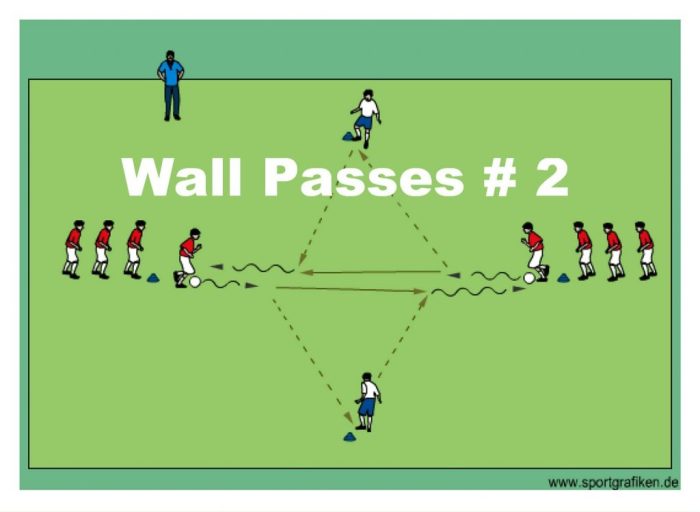Football teamwork drills: Enhancing Performance and Cohesion. Get ready to dive into the world of teamwork drills in football, where communication, trust, and collaboration take center stage. Let’s explore how these drills can level up your game!
Whether you’re a seasoned player or just starting out, understanding the types, design, and implementation of teamwork drills is crucial for success on the field. Let’s break it down for you!
The Importance of Football Teamwork Drills
Football teamwork drills are essential in training as they help players develop a strong bond and understanding on the field. These drills not only improve team cohesion but also enhance overall performance by promoting effective communication and trust among players.
Enhanced Communication
Teamwork drills require players to communicate effectively with each other to execute plays successfully. By practicing together, players learn to understand each other’s movements, strengths, and weaknesses, leading to better coordination during games.
Building Trust
Through teamwork drills, players build trust in each other’s abilities, knowing that each member of the team has a specific role to play. This trust is crucial during high-pressure situations in games, as players rely on each other to make split-second decisions and work towards a common goal.
Improved Team Cohesion, Football teamwork drills
Teamwork drills create a sense of unity among players as they work towards a shared objective. By focusing on collaborating and supporting each other, teams can overcome challenges together, leading to a stronger bond both on and off the field.
Types of Football Teamwork Drills
In football, teamwork drills are essential for building strong communication and collaboration among players. These drills help improve coordination on the field and enhance overall team performance.
Passing and Moving Drills
Passing and moving drills focus on quick, accurate passes between players while also moving into open spaces to receive the ball. This drill helps players develop their passing accuracy, timing, and decision-making skills on the field.
- Two-Touch Passing: Players are limited to two touches before passing the ball, encouraging quick decision-making and precise passing.
- Triangle Passing: Players form a triangle and pass the ball quickly between each other, emphasizing movement off the ball and communication.
Positional Drills
Positional drills focus on specific positions on the field, helping players understand their roles and responsibilities within the team structure. These drills improve players’ awareness of their position and enhance teamwork in executing game strategies.
- Overlap Drill: Players practice overlapping runs to create space and options for their teammates, emphasizing coordination and timing between players.
- Zonal Defending: Players work together to defend specific zones on the field, improving communication and organization in the defense.
Small-Sided Games
Small-sided games involve fewer players on a smaller field, promoting quick decision-making, teamwork, and creativity. These games simulate real match scenarios and encourage players to work together to achieve a common goal.
- 3v3 Possession Game: Players work in small groups to maintain possession of the ball, focusing on quick passing, movement, and support from teammates.
- 5v5 Scrimmage: Players compete in a small-sided game to score goals, requiring teamwork, communication, and coordination to succeed against the opposition.
Designing Effective Teamwork Drills
Creating engaging and effective teamwork drills is crucial for the success of a football team. These drills not only help players improve their skills but also foster better communication and collaboration on the field.
Incorporating Challenges and Goals
To make teamwork drills more engaging, it is essential to incorporate challenges and goals that push players to work together towards a common objective. Setting specific targets, such as completing a certain number of passes in a set time or scoring a goal through a particular play, can motivate players to communicate effectively and strategize as a team.
- Set clear objectives for each drill to give players a sense of purpose and direction.
- Introduce competitive elements like timed challenges or small-sided games to simulate real match situations.
- Encourage players to problem-solve and come up with creative solutions to overcome obstacles during drills.
Challenges and goals in teamwork drills help players develop a competitive mindset and improve their decision-making skills under pressure.
Adapting Drills to Team Dynamics
Every team has its unique dynamics and playing style, so it is crucial to adapt drills to suit the specific needs and strengths of the players. Consider factors such as the team’s level of experience, individual skill sets, and preferred strategies when designing teamwork drills.
- Observe how players interact and communicate during drills to identify areas that need improvement.
- Modify drills to cater to different playing positions and roles within the team.
- Encourage feedback from players to continuously refine and adjust drills based on their input and observations.
By customizing drills to align with the team’s dynamics and playing style, coaches can maximize the effectiveness of training sessions and help players develop stronger bonds and synergy on the field.
Implementing Teamwork Drills in Football Training: Football Teamwork Drills

Teamwork drills are a crucial component of football training, as they help players develop the communication, coordination, and trust needed to perform well on the field. Implementing these drills in a structured manner can greatly enhance a team’s performance and overall cohesion.
Frequency and Duration of Teamwork Drills
- Teamwork drills should be incorporated into training sessions regularly, ideally multiple times per week.
- The duration of these drills can vary depending on the specific focus and goals, but they should typically last anywhere from 15 to 30 minutes per session.
- It’s important to strike a balance between repetition and variety in teamwork drills to keep players engaged and continuously improving.
Monitoring and Evaluating Effectiveness
- Coaches should observe players during teamwork drills to assess their communication, decision-making, and execution of plays.
- Feedback and constructive criticism should be provided to help players understand their strengths and areas for improvement.
- Tracking team performance in game situations can also provide valuable insights into the effectiveness of teamwork drills and areas that may need further focus.
